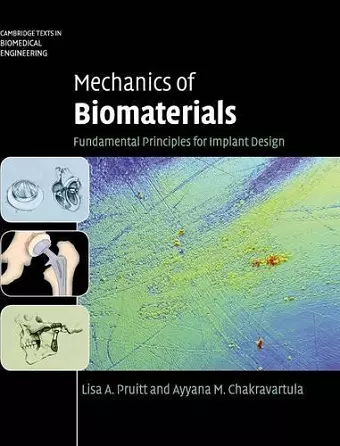Mechanics of Biomaterials
Fundamental Principles for Implant Design
Lisa A Pruitt author Ayyana M Chakravartula author
Format:Hardback
Publisher:Cambridge University Press
Published:20th Oct '11
Currently unavailable, and unfortunately no date known when it will be back

Combining materials science, mechanics, implant design and clinical applications, this self-contained text provides a complete grounding to the field.
Teaching mechanical and structural biomaterial concepts for successful implant design, this self-contained text is suitable for engineers, scientists and clinicians. Medical device case studies (including orthopedics, cardiovascular medicine, dentistry and soft tissues), step-by-step design guidelines and problem sets throughout, make this book ideal for course use and for self study.Teaching mechanical and structural biomaterials concepts for successful medical implant design, this self-contained text provides a complete grounding for students and newcomers to the field. Split into three sections: Materials, Mechanics and Case Studies, it begins with a review of sterilization, biocompatibility and foreign body response before presenting the fundamental structures of synthetic biomaterials and natural tissues. Mechanical behavior of materials is then discussed in depth, covering elastic deformation, viscoelasticity and time-dependent behavior, multiaxial loading and complex stress states, yielding and failure theories, and fracture mechanics. The final section on clinical aspects of medical devices provides crucial information on FDA regulatory issues and presents case studies in four key clinical areas: orthopedics, cardiovascular devices, dentistry and soft tissue implants. Each chapter ends with a list of topical questions, making this an ideal course textbook for senior undergraduate and graduate students, and also a self-study tool for engineers, scientists and clinicians.
'Mechanics of Biomaterials is the textbook I have been waiting for. This comprehensive work synthesizes the science and engineering of biomaterials that has developed over the past three decades into a highly useful textbook for training students … as I reviewed this work it felt like I was reviewing my own lecture notes developed over 20 years. [It] combines materials science, mechanics and medical device design and analysis in a seamless and thorough manner incorporating many critical studies from the literature into a clear and comprehensive work … Pruitt and Chakravartula have succeeded in developing an outstanding text and reference book that should be required reading for all who aspire to design, develop and evaluate medical devices.' Jeremy L. Gilbert, Syracuse University
'… a detailed yet easy-to-read book that can be used by materials scientists and biomedical engineers, from both the budding biomedical engineering student to the seasoned medical device designer. It combines the fundamentals of plastics, metals, and ceramics behavior with the required properties for the often challenging loading and environmental conditions found in the body. I particularly liked Pruitt and Chakravartula's technique of introducing a detailed discussion of the theoretical explanation of a particular material class's response to a loading environment, and then providing a real-life case study demonstrating how the theoretical response translates to clinical performance … The book is rich in practical examples of biomaterials used in permanent implants currently on the market. Sufficient historical information is provided on implant successes and failures to appreciate the challenges for material and design selection in the areas of both hard and soft tissue replacement.' Stephen Spiegelberg, Cambridge Polymer Group, Inc.
'Mechanics of Biomaterials: Fundamental Principles for Implant Design provides a much needed comprehensive resource for engineers, physicians, and implant designers at every level of training and practice. The book includes a historical background which outlines the engineering basis of traditional implant designs, and interactions of materials, biology, and mechanics resulting in clinical success or failure of these devices. Each chapter contains a detailed description of the engineering principles which are critical to understand the mechanical behavior of biomaterials and implants in vivo. The scope of the text covers orthopaedics, cardiovascular devices, dental, and soft tissue implants, and should help considerably in our efforts to improve the function and durability of biomaterials and implants used in clinical practice.' Michael Ries, University of California, San Francisco
ISBN: 9780521762212
Dimensions: 254mm x 203mm x 38mm
Weight: 1620g
698 pages